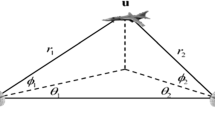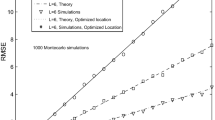Abstract
The accuracy of passive localization is impacted by the position of the receiving stations. In practical applications, signal reception is frequently influenced by the emission angle of the target signal, which makes it a challenge to ensure localization accuracy. We present an optimal placement method for TDOA localization with constraints on the signal angle. Firstly, we establish a localization error model based on polar coordinates, which reveals that the localization error is solely dependent on the angular relationships between the target and receiving stations. We determine the optimal locations of the stations without constraints. We then introduce a novel approach where the quarter-angle and one-fifth angle within the emitted beam angle are employed as critical values to determine station placement. Given the constraint of the angle, we use the critical values to evaluate the angular relationship between the station and the target, determining if the station should be positioned on the boundary or on the angle bisector to achieve optimal placement method. Finally, we validate our proposed method through simulations, demonstrating its ability to minimize errors in various scenarios. The method proposed provides an effective solution to the challenge of target localization with constraints on the received signal beam angle.


















Similar content being viewed by others
Data Availability
The datasets generated during and analyzed during the current study are available from the first author on reasonable request.
References
Torrieri, D. J. (1984). Statistical theory of passive location systems. IEEE Transactions on Aerospace and Electronic Systems AES, 20(2), 183–198. https://doi.org/10.1109/TAES.1984.310439
Rappaport, T. S., Reed, J. H., & Woerner, B. D. (1996). Position location using wireless communications on highways of the future. IEEE Communications Magazine, 34(10), 33–41. https://doi.org/10.1109/35.544321
Dogancay, K. (2006). Bias compensation for the bearings-only pseudolinear target track estimator. IEEE Transactions on Signal Processing, 54(1), 59–68. https://doi.org/10.1109/TSP.2005.861088
Ho, K. C., & Xu, W. (2004). An accurate algebraic solution for moving source location using tdoa and fdoa measurements. IEEE Transactions on Signal Processing, 52(9), 2453–2463. https://doi.org/10.1109/TSP.2004.831921
Joshi, S., & Boyd, S. (2009). Sensor selection via convex optimization. IEEE Transactions on Signal Processing, 57(2), 451–462. https://doi.org/10.1109/TSP.2008.2007095
Tharmarasa, R., Kirubarajan, T., Sinha, A., & Lang, T. (2011). Decentralized sensor selection for large-scale multisensor-multitarget tracking. IEEE Transactions on Aerospace and Electronic Systems, 47(2), 1307–1324. https://doi.org/10.1109/TAES.2011.5751260
Yang, C., Kaplan, L., & Blasch, E. (2012). Performance measures of covariance and information matrices in resource management for target state estimation. IEEE Transactions on Aerospace and Electronic Systems, 48(3), 2594–2613. https://doi.org/10.1109/TAES.2012.6237611
Abel, J.S. (1990). Optimal sensor placement for passive source localization. In: International Conference on Acoustics, Speech, and Signal Processing, pp. 2927–29305. https://doi.org/10.1109/ICASSP.1990.116239
Ho, K. C., & Vicente, L. M. (2008). Sensor allocation for source localization with decoupled range and bearing estimation. IEEE Transactions on Signal Processing, 56(12), 5773–5789. https://doi.org/10.1109/TSP.2008.2005096
Lui, K. W. K., & So, H. C. (2009). A study of two-dimensional sensor placement using time-difference-of-arrival measurements. Digital Signal Processing, 19(4), 650–659. https://doi.org/10.1016/j.dsp.2009.01.002
Bishop, A. N., Fidan, B., Anderson, B. D. O., Doǧançay, K., & Pathirana, P. N. (2010). Optimality analysis of sensor-target localization geometries. Automatica, 46(3), 479–492. https://doi.org/10.1016/j.automatica.2009.12.003
Ma, W., Zhu, H., & Lin, Y. (2019). Multi-sensor passive localization based on sensor selection. In: 2019 22th International Conference on Information Fusion (FUSION), pp. 1–8 https://doi.org/10.23919/FUSION43075.2019.9011312
Zhao, Y., Li, Z., Hao, B., & Shi, J. (2019). Sensor selection for tdoa-based localization in wireless sensor networks with non-line-of-sight condition. IEEE Transactions on Vehicular Technology, 68(10), 9935–9950. https://doi.org/10.1109/TVT.2019.2936110
Zhao, Y., Wang, R., Li, Z., Hao, B., & Wang, D. (2021). Joint sensor selection and placement in partially controllable localization networks. In: 2021 IEEE/CIC International Conference on Communications in China (ICCC), pp. 682–687. https://doi.org/10.1109/ICCC52777.2021.9580428
Panwar, K., Fatima, & G., Babu, P. (2022). Optimal sensor placement for hybrid source localization using fused toa-rss-aoa measurements. IEEE Transactions on Aerospace and Electronic Systems, 1–15 https://doi.org/10.1109/TAES.2022.3202879
Xu, S., Ou, Y., & Wu, X. (2019). Optimal sensor placement for 3-d time-of-arrival target localization. IEEE Transactions on Signal Processing, 67(19), 5018–5031. https://doi.org/10.1109/TSP.2019.2932872
Xu, S., Wu, L., Doǧançay, K., & Alaee-Kerahroodi, M. (2022). A hybrid approach to optimal toa-sensor placement with fixed shared sensors for simultaneous multi-target localization. IEEE Transactions on Signal Processing, 70, 1197–1212. https://doi.org/10.1109/TSP.2022.3152232
Lawrence, D. E. (2010). Low probability of intercept antenna array beamforming. IEEE Transactions on Antennas and Propagation, 58(9), 2858–2865. https://doi.org/10.1109/TAP.2010.2052573
Sulistyaningsih, Saputera, Y.P., & Wahab, M. (2016). Radar signal processing development for low probability of intercept radar system. In: 2016 IEEE Region 10 Conference (TENCON), pp. 946–950 https://doi.org/10.1109/TENCON.2016.7848144
Wang, Z., Hu, D., Huang, J., Zhao, C., Liu, C., & Xie, M. (2022). Optimal deployment of receiving stations under far-field localization conditions. In: 2022 IEEE/CIC International Conference on Communications in China (ICCC), pp. 423–428 https://doi.org/10.1109/ICCC55456.2022.9880659
Fang, X., Li, J., Zhang, S., Chen, W., & He, Z. (2022). Optimal aoa sensor-source geometry with deployment region constraints. IEEE Communications Letters, 26(4), 793–797. https://doi.org/10.1109/LCOMM.2022.3144152
Sadeghi, M., Behnia, F., & Amiri, R. (2020). Optimal sensor placement for 2-d range-only target localization in constrained sensor geometry. IEEE Transactions on Signal Processing, 68, 2316–2327. https://doi.org/10.1109/TSP.2020.2985645
Sadeghi, M., Behnia, F., & Amiri, R. (2021). Optimal geometry analysis for tdoa-based localization under communication constraints. IEEE Transactions on Aerospace and Electronic Systems, 57(5), 3096–3106. https://doi.org/10.1109/TAES.2021.3069269
Xu, S., Rice, M., & Rice, F. (2021). Optimal toa-sensor placement for two target localization simultaneously using shared sensors. IEEE Communications Letters, 25(8), 2584–2588. https://doi.org/10.1109/LCOMM.2021.3083058
Acknowledgements
This work is jointly funded by the National Natural Science Foundation of China (NSFC) under Grant No. 62071490, and the Natural Science Outstanding Youth Fund of Henan province under Grant No. 212300410095.
Author information
Authors and Affiliations
Corresponding author
Ethics declarations
Conflicts of interest
The authors declare that they have no known competing financial interests or personal relationships that could have appeared to influence the work reported in this paper.
Additional information
Publisher's Note
Springer Nature remains neutral with regard to jurisdictional claims in published maps and institutional affiliations.
Rights and permissions
Springer Nature or its licensor (e.g. a society or other partner) holds exclusive rights to this article under a publishing agreement with the author(s) or other rightsholder(s); author self-archiving of the accepted manuscript version of this article is solely governed by the terms of such publishing agreement and applicable law.
About this article
Cite this article
Wang, Z., Hu, D., Huang, J. et al. Optimal Station Placement Method for Three-Station TDOA Localization Under Signal Beam Constraint. Wireless Pers Commun 133, 119–149 (2023). https://doi.org/10.1007/s11277-023-10754-0
Accepted:
Published:
Issue Date:
DOI: https://doi.org/10.1007/s11277-023-10754-0




